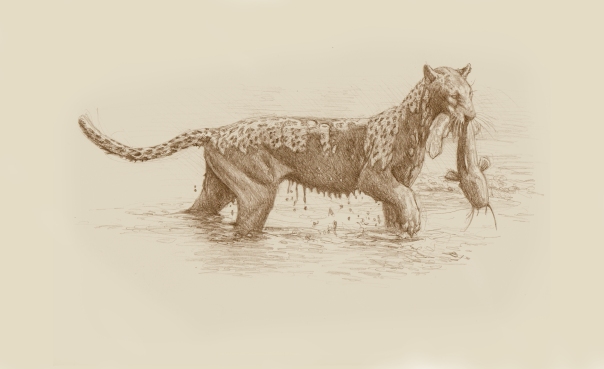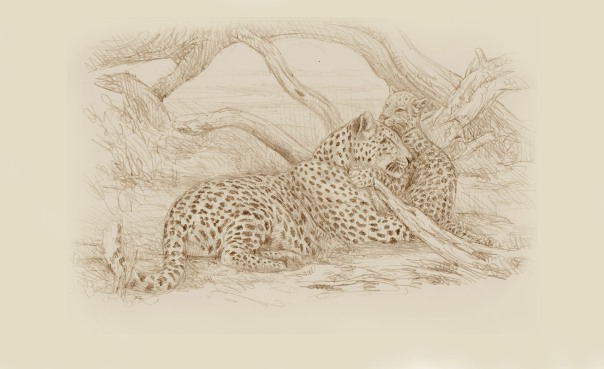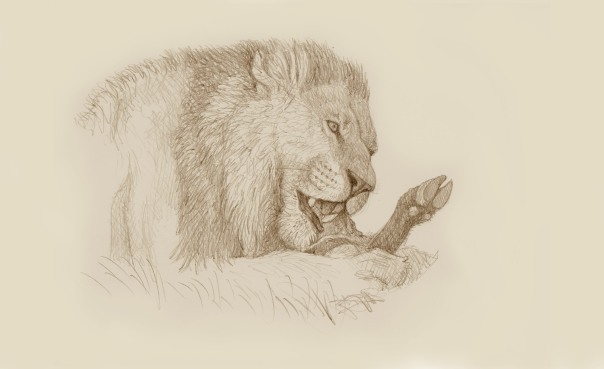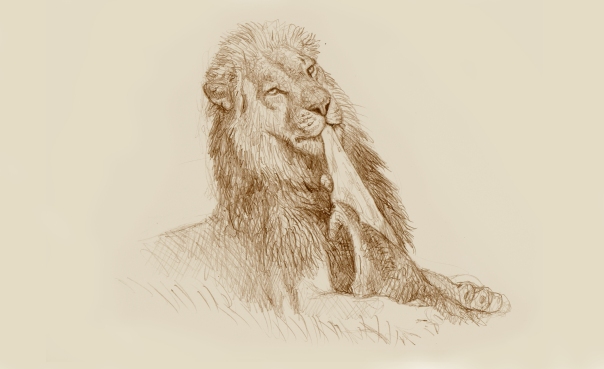Join our “Drawing the Big Cats” safari!
Spring has come and it is time to begin our preparations for this year’s edition of “Drawing the Big Cats”! It may seem like there is a lot of time left until late August, but a trip like this requires quite some planning ahead. After four editions of this amazing safari, there are countless memories of incredible encounters with the wildlife of Northern Botswana, but our 2015 trip stands as one of the most memorable, if nothing else because we could see the fishing leopard of Savuti in action! Here are some impressions from our feline encounters of that year:
If you want to learn more about this incredible trip contact Elephant Trails safaris at: edurne@africapridebotswana.com
And if you want to picture yourself there, here is a summary of the itinerary to help boost your imagination:
DRAWING THE BIG CATS SAFARI: ITINERARY.
This is an overland safari where we spend all our time in the remote wilderness of Botswana. During the game drives we will concentrate on watching the wildlife, and making photographs or videos is the priority especially during our encounters with the big cats which are usally brief and always unpredictable. However, on particular occasions we will be able to use our sketchbook and pencil for some live sketching. It will be during the lunch stop or back at camp that we will have our drawing classes and learn about the structure, shape and action of the felines and how to materialise it in our sketches. On some evenings we will also have presentations about big cat evolution, behaviour and adaptations, all of which will enrich our experience of the real animals in the wild.
Day 1. Sedia Hotel – Maun
Arrive in Maun, the safari capital of Botswana, and overnight in the Sedia Hotel on a dinner, bed and breakfast basis. We take a scenic flight over the Oklavango Delta for a breathtaking vew of some of the wilderness that we will be visiting over the following days. For bird enthusiasts there is a chance to watch some of the most colourful local bird species up close at the hotel’s garden bird feeders.
Day 2 & 3. Xakanaxa – Moremi Game Reserve
We depart Maun and travel the 5-6 hour journey into the Moremi Game Reserve which is situated in the Okavango Delta. Here we will camp in a private campsite in the heart of the waterways of the Okavango Delta.
Day 2 takes us on a boat ride on the main channels and lagoon systems of the northern reaches of the Okavango Delta. There is a great variety of birdlife along these channels, and mammals such as the elusive otter and majestic lechwe may be seen. If we are lucky we may even see an elephant cooling off in the clear waters or catch a glimpse of the shy sitatunga.
We usually spend most of the day out so we will pack a picnic lunch to be enjoyed in a shady spot in this picturesque part of Moremi. In the evening we return to camp for warm shower and a hearty meal while listening to the sounds of the African bush at night. LDBB
Days’ 4 & 5. Khwai – Moremi Game Reserve
After enjoying our early morning breakfast and clearing our tents we start our journey to the Eastern most extremity of the Okavango Delta.
The Khwai area is rich in habitat and wildlife. The animals are attracted to the narrow ribbon of water that is the Khwai River and this provides for some spectacular wildlife viewing. This is an area where lion and leopard may be seen. There is a healthy population of plains game, including kudu, impala, giraffe and zebra.
Here we will spend our days doing game drives and also have a chance to relax and catch up with our diaries during the siesta time of the afternoon on day 5. LDBB
Days’ 6 & 7. Savuti – Chobe National Park
Today we have a 6 – 7 hour journey to Savuti- we will be travelling through wilderness area for the whole journey. This is a day that puts into perspective the sheer size of this wilderness area.
Savuti lies in an ancient lake bed that is punctuated with small rocky hills (kopjes), some of which hold ancient San rock paintings. Here we explore the Savuti marsh and river bed for the abundant wildlife of this timeless place, including its famous elephant and lion population. Wild dog are regularly seen as well as a large variety of other mammals.
Savuti is a favoured area of wildlife- photographers as well as film-makers and many well known wildlife documentaries have been filmed here.
Days 8 & 9. Chobe River Front – Chobe National Park
Today’s journey takes us out of the ancient lake bed and Kalahari basin , through the teak forests that make up the north eastern part of Botswana.
For a long part of the journey we will follow in the footsteps of famous missionary and explorer Dr David Livingstone. We pass through some villages that are recorded by him in his books about his travels. The Chobe river floodplain is undoubtedly one of the greatest wildlife areas on the continent and one is sometimes overwhelmed by the sheer numbers of animals. Here we divide our time between game drives along the river and in the forest and a boat cruise on the Chobe River which is one of the highlights of the trip. We will also have some time to do some curio shopping in the village of Kasane.
Day 10. Victoria Falls
Today we leave our camp for the last time as we are transferred to Victoria Falls.
Here we will overnight in a comfortable hotel.
We will have time to spend a few hours at the world famous “Smoke that Thunders” or in the local Batonka language “Mosi Oa Tunya”.(The entry fee is the responsibility of guest) It is one of the 7 natural wonders of the world .
There are also optional activities including white water rafting, helicopter flights or even bungee jumping. The restaurant dinner that evening is the responsibility of the guest.
Posted on 30/03/2017, in Uncategorized. Bookmark the permalink. 4 Comments.




Argh, honeymooning in New Zealand. 🙂 One of these years, I must do this. Have fun and I hope you folks have more peculiar wildlife encounters!
Sounds like you will not be having a bad time either… enjoy New Zealand!
Awesome!
I absolutely love the first piece, and I am in general a great fan of your work (I am reading Mammoths, Sabertooths, and Hominids, currently).
A a bit off-topic question – do you know the dimensions of Sivatherium giganteum? I know that a study showed shortly ago that It may weighted more than a adult Giraffe, but I can’t find the concrete size/weight.
Thanks
Hello Dustin, according to a recent estimate published by Basu and colleagues last year, the mean body mass of Sivatherium gianteum would have been around 1,250 Kg., so overlapping with extant giraffes.